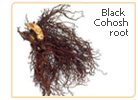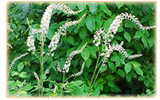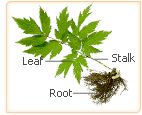What is Black Cohosh
Black cohosh is an herb commonly found along the east coast of North America. In the past people have used black cohosh to treat a wide range of medical problems, but today it is more commonly thought of as a treatment for the symptoms of menopause. Keep reading below to discover more about the origins of black cohosh.
Origins of Black Cohosh
 Sometimes spelt as black kohosh, the black cohosh herb has been used in North American alternative medicine for centuries. Tribes believed this herb helped relieve menstrual cramps, menopausal hot flashes, arthritis, muscle pain, sore throat, coughs, and indigestion. Sometimes spelt as black kohosh, the black cohosh herb has been used in North American alternative medicine for centuries. Tribes believed this herb helped relieve menstrual cramps, menopausal hot flashes, arthritis, muscle pain, sore throat, coughs, and indigestion.
Cohosh is a Native American word that means "knobby rough roots", a phrase describing the black cohosh plant.
Different Names of Cohosh
The black cohosh herb has the Latin name Actaea racemosa or Cimicifuga racemosa, and it is a member of the buttercup family. Over time it has been given other names such as:
.  Black snakeroot Black snakeroot
. Bugbane
. Bugwort
. Rattleroot
. Rattletop
. Rattleweed
. Macrotys
Although there is a different species of plant named blue cohosh, it is important that these two herbal supplements do not become confused, particularly because blue cohosh is thought to have more severe side effects than black cohosh and can be dangerous.
How does Black Cohosh Grow?
 Normally grown in woodland areas, the Black Cohosh Root or Rhizomes (underground stems) are the most commonly used part of the plant. These can be ground up and made into a tablet form or added to a liquid, such as ethanol, and used as a tonic. Keep reading to learn about what black cohosh looks like. Normally grown in woodland areas, the Black Cohosh Root or Rhizomes (underground stems) are the most commonly used part of the plant. These can be ground up and made into a tablet form or added to a liquid, such as ethanol, and used as a tonic. Keep reading to learn about what black cohosh looks like.
What does Black Cohosh look like?
Black Cohosh can be identified by its tall, white flower, which stems from June to August, as well as its irregular, jagged leaves. This plant can grow up to eight feet tall and from August to November it bears dark blue berries. Information about the chemical composition of the black cohosh herb can be found below.
Pharmacology and Chemical Composition
 As a phytoestrogenic herb, black cohosh is thought to produce its own type of plant hormone, known as cimicifugin (macrotin), which has similar properties to estrogen. For this reason, black cohosh can be used to supplement women's decreasing estrogen levels during perimenopause and menopause. More recently however, this theory has been questioned by research which suggests that no estrogen-binding or estrogen-like characteristics appear in black cohosh. As a phytoestrogenic herb, black cohosh is thought to produce its own type of plant hormone, known as cimicifugin (macrotin), which has similar properties to estrogen. For this reason, black cohosh can be used to supplement women's decreasing estrogen levels during perimenopause and menopause. More recently however, this theory has been questioned by research which suggests that no estrogen-binding or estrogen-like characteristics appear in black cohosh.
Although the real key is to the herbs� success in treating menopause symptoms remains unknown, it is known that black cohosh�s antihypertensive effects and anti-inflammatory effects may explain why this herbs helps women to treat menstrual problems, as well as conditions such as rheumatism.
The American College of Obstetricians and Gynecologists has stated that cohosh may be helpful only in the short-term (six months or less) for women suffering from menopausal hot flashes and mood swings. Although the use of Black Cohosh for a long/an extensive period of time can do more harm than good.
Now that it�s been explained what is black cohosh and its origins as a herb for menopause. Click on the following link to learn about how black cohosh works.
Conclusions about Black Cohosh
Black cohosh can be effective in treating some menopause symptoms, but it has recently been criticized because it adds artificial hormones to the body. By doing so, black cohosh can trigger side effects which could lead to serious conditions such as breast cancer.
Other alternative treatments are just as effective as black cohosh, but without the unwanted side effects. Non-estrogenic herbs, for example, are a great option for treating menopause symptoms. Read more in the following article.
Which herb should women try? Today women are looking for relief from their menopause symptoms with herbs. Phytoestrogenic herbs and non-estrogenic herbs are good in relieving menopause symptoms, but recent studies show that non-estrogenic herbs have no side effects because they help the body to produce its own hormones instead of introducing hormones like the phytoestrogenic ones. Learn more about non-estrogenic herbs for menopause.
| 

